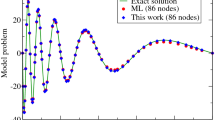Abstract
The three-dimensional stochastic drift–diffusion–Poisson system is used to model charge transport through nanoscale devices in a random environment. Applications include nanoscale transistors and sensors such as nanowire field-effect bio- and gas sensors. Variations between the devices and uncertainty in the response of the devices arise from the random distributions of dopant atoms, from the diffusion of target molecules near the sensor surface, and from the stochastic association and dissociation processes at the sensor surface. Furthermore, we couple the system of stochastic partial differential equations to a random-walk-based model for the association and dissociation of target molecules. In order to make the computational effort tractable, an optimal multi-level Monte–Carlo method is applied to three-dimensional solutions of the deterministic system. The whole algorithm is optimal in the sense that the total computational cost is minimized for prescribed total errors. This comprehensive and efficient model makes it possible to study the effect of design parameters such as applied voltages and the geometry of the devices on the expected value of the current.














Similar content being viewed by others
References
Stern, E., Klemic, J.F., Routenberg, D.A., Wyrembak, P.N., Turner-Evans, D.B., Hamilton, A.D., LaVan, D.A., Fahmy, T.M., Reed, M.A.: Label-free immunodetection with CMOS-compatible semiconducting nanowires. Nature 445(7127), 519–522 (2007)
Stern, E., Vacic, A., Rajan, N.K., Criscione, J.M., Park, J., Ilic, B.R., Mooney, D.J., Reed, M.A., Fahmy, T.M.: Label-free biomarker detection from whole blood. Nat. Nanotechnol. 5(2), 138–142 (2010)
Tulzer, G., Heitzinger, C.: Fluctuations due to association and dissociation processes at nanowire-biosensor surfaces and their optimal design. Nanotechnology 26(2), 025502/1–9 (2015). https://doi.org/10.1088/0957-4484/26/2/025502
Tulzer, G., Heitzinger, C.: Brownian-motion based simulation of stochastic reaction–diffusion systems for affinity based sensors. Nanotechnology 27(16), 165501/1–9 (2016). https://doi.org/10.1088/0957-4484/27/16/165501
Heitzinger, C., Mauser, N.J., Ringhofer, C.: Multiscale modeling of planar and nanowire field-effect biosensors. SIAM J. Appl. Math. 70(5), 1634–1654 (2010)
Baumgartner, S., Heitzinger, C.: Existence and local uniqueness for 3D self-consistent multiscale models for field-effect sensors. Commun. Math. Sci 10(2), 693–716 (2012)
Heitzinger, C., Ringhofer, C.: Multiscale modeling of fluctuations in stochastic elliptic PDE models of nanosensors. Commun. Math. Sci. 12(3), 401–421 (2014). https://doi.org/10.4310/CMS.2014.v12.n3.a1
Khodadadian, A., Hosseini, K., Manzour ol Ajdad, A., Hedayati, M., Kalantarinejad, R., Heitzinger, C.: Optimal design of nanowire field-effect troponin sensors. Comput. Biol. Med. 87, 46–56 (2017)
Roy, G., Brown, A.R., Adamu-Lema, F., Roy, S., Asenov, A.: Simulation study of individual and combined sources of intrinsic parameter fluctuations in conventional nano-MOSFETs. IEEE Trans. Electron Devices 53(12), 3063–3070 (2006)
Seoane, N., Martinez, A., Brown, A.R., Barker, J.R., Asenov, A.: Current variability in Si nanowire MOSFETs due to random dopants in the source/drain regions: a fully 3-D NEGF simulation study. IEEE Trans. Electron Devices 56(7), 1388–1395 (2009)
Taghizadeh, L., Khodadadian, A., Heitzinger, C.: The optimal multilevel Monte–Carlo approximation of the stochastic drift–diffusion–Poisson system. Comput. Methods Appl. Mech. Eng. 318, 739–761 (2017). https://doi.org/10.1016/j.cma.2017.02.014
Khodadadian, A., Taghizadeh, L., Heitzinger, C.: Optimal multilevel randomized quasi-Monte-Carlo method for the stochastic drift-diffusion-Poisson system. Comput. Methods Appl. Mech. Eng. 329, 480–497 (2018)
Kuo, F.Y.: Component-by-component constructions achieve the optimal rate of convergence for multivariate integration in weighted korobov and sobolev spaces. J. Complex. 19(3), 301–320 (2003)
Heitzinger, C., Taghizadeh, L.: Existence and local uniqueness for the stochastic drift–diffusion–Poisson system. (Submitted for publication)
Hockney, R.W., Eastwood, J.W.: Computer Simulation Using Particles. CRC Press, Boca Raton (1988)
Sano, N., Matsuzawa, K., Mukai, M., Nakayama, N.: On discrete random dopant modeling in drift–diffusion simulations: physical meaning of atomistic dopants. Microelectron. Reliab. 42(2), 189–199 (2002)
Jiang, X.-W., Deng, H.-X., Luo, J.-W., Li, S.-S., Wang, L.-W.: A fully three-dimensional atomistic quantum mechanical study on random dopant-induced effects in 25-nm MOSFETs. IEEE Trans. Electron Devices 55(7), 1720–1726 (2008)
Chen, D., Wei, G.-W.: Modeling and simulation of electronic structure, material interface and random doping in nano-electronic devices. J. Comput. Phys. 229(12), 4431–4460 (2010)
Khodadadian, A., Heitzinger, C.: Basis adaptation for the stochastic nonlinear Poisson–Boltzmann equation. J. Comput. Electron. 15(4), 1393–1406 (2016)
Patolsky, F., Lieber, C.M.: Nanowire nanosensors. Mater. Today 8(4), 20–28 (2005)
Cliffe, K., Giles, M., Scheichl, R., Teckentrup, A.L.: Multilevel Monte Carlo methods and applications to elliptic PDEs with random coefficients. Comput. Vis. Sci. 14(1), 3–15 (2011)
Charrier, J., Scheichl, R., Teckentrup, A.L.: Finite element error analysis of elliptic PDEs with random coefficients and its application to multilevel Monte Carlo methods. SIAM J. Numer. Anal. 51(1), 322–352 (2013)
Baumgartner, S., Heitzinger, C., Vacic, A., Reed, M.A.: Predictive simulations and optimization of nanowire field-effect PSA sensors including screening. Nanotechnology 24(22), 225503/1–9 (2013). https://doi.org/10.1088/0957-4484/24/22/225503
Colinge, J.-P., et al.: FinFETs and Other Multi-Gate Transistors. Springer, Berlin (2008)
Acknowledgements
The authors acknowledge support by FWF (Austrian Science Fund) START Project No. Y660 PDE Models for Nanotechnology. The authors also acknowledge discussions with Gerhard Tulzer.
Author information
Authors and Affiliations
Corresponding author
Rights and permissions
About this article
Cite this article
Khodadadian, A., Taghizadeh, L. & Heitzinger, C. Three-dimensional optimal multi-level Monte–Carlo approximation of the stochastic drift–diffusion–Poisson system in nanoscale devices. J Comput Electron 17, 76–89 (2018). https://doi.org/10.1007/s10825-017-1118-0
Published:
Issue Date:
DOI: https://doi.org/10.1007/s10825-017-1118-0




